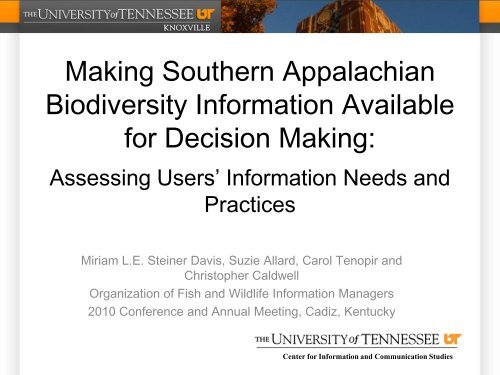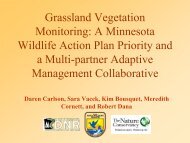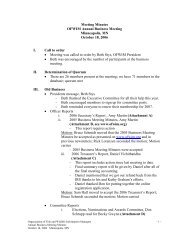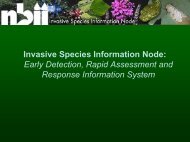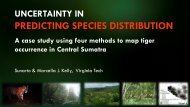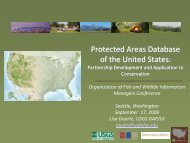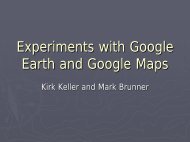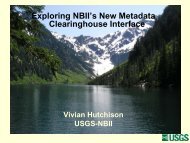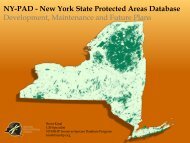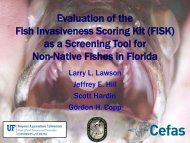Making Southern Appalachian Biodiversity Information Available for ...
Making Southern Appalachian Biodiversity Information Available for ...
Making Southern Appalachian Biodiversity Information Available for ...
Create successful ePaper yourself
Turn your PDF publications into a flip-book with our unique Google optimized e-Paper software.
<strong>Making</strong> <strong>Southern</strong> <strong>Appalachian</strong><strong>Biodiversity</strong> <strong>In<strong>for</strong>mation</strong> <strong>Available</strong><strong>for</strong> Decision <strong>Making</strong>:Assessing Users’ <strong>In<strong>for</strong>mation</strong> Needs andPracticesMiriam L.E. Steiner Davis, Suzie Allard, Carol Tenopir andChristopher CaldwellOrganization of Fish and Wildlife <strong>In<strong>for</strong>mation</strong> Managers2010 Conference and Annual Meeting, Cadiz, KentuckyCenter <strong>for</strong> <strong>In<strong>for</strong>mation</strong> and Communication Studies
Overview• Background• Problem• Assessment project• Preliminary results• Implications <strong>for</strong> fish and wildlifein<strong>for</strong>mation managementCenter <strong>for</strong> <strong>In<strong>for</strong>mation</strong> and Communication Studies
Background<strong>Biodiversity</strong> in<strong>for</strong>mation is key to:• establishing baseline biological in<strong>for</strong>mation• understanding biological & ecological processes• predicting impacts from change• generating scientific discovery• making decisions and evaluating options• managing natural resourcesCenter <strong>for</strong> <strong>In<strong>for</strong>mation</strong> and Communication Studies
<strong>Southern</strong> <strong>Appalachian</strong> <strong>In<strong>for</strong>mation</strong> Node (SAIN)Your Gateway to Regional <strong>Biodiversity</strong> <strong>In<strong>for</strong>mation</strong>EnvironmentalorganizationaldecisionmakersClimateChangeRenewableEnergyResourcesSAINEducators,students &the publicScientists &ResearchersAquaticResourcesCenter <strong>for</strong> <strong>In<strong>for</strong>mation</strong> and Communication Studies
ProblemHow to best make <strong>Southern</strong> <strong>Appalachian</strong>biodiversity in<strong>for</strong>mation available <strong>for</strong>research, decision making and education?1. What in<strong>for</strong>mation is needed?2. What in<strong>for</strong>mation sources are currently used andwhy?3. Are users finding the in<strong>for</strong>mation they need &how?4. How do these vary by user group?
User Needs Assessment• Internet survey (as of 10/5/2010)– All faculty in life and agricultural sciences (and somein physical, technical and social sciences)– All first and second tier universities in SAIN region– Attendees from related regional conference– SAIN identified partners and stakeholders– (Non-profits, collections and herbaria)• 269 valid surveys received• 5661 sent~ 5% response rateCenter <strong>for</strong> <strong>In<strong>for</strong>mation</strong> and Communication Studies
Preliminary Results• 60% say Half or More Than Half of thein<strong>for</strong>mation they need to do their workrelates specifically to biodiversity.• 31% say this in<strong>for</strong>mation is Difficult or VeryDifficult to Find
Preliminary Results• Focus of work or complete focus of work:‣15% Bioenergy‣20% Climate Change‣34% Aquatic Resource Management andRestoration
Preliminary Results• Primary role• 62% Researchers• 14% Educators• 22% equally among program managers,implementers, decision makers, consultants,etc.Center <strong>for</strong> <strong>In<strong>for</strong>mation</strong> and Communication Studies
Preliminary Results• Primary work sector• 73% Academic• 15% Government• 8% Non-profit• 4% For profitCenter <strong>for</strong> <strong>In<strong>for</strong>mation</strong> and Communication Studies
1. What in<strong>for</strong>mation is needed?Type. . . is HALF orMORE THAN HALFof biod. infoneeded to do work.. . . is DIFFICULT orVERY DIFFICULTto find.Raw data 63% 40%Models* 53% 35%Summarizeddata35% 36%
1. What in<strong>for</strong>mation is needed?Most Frequent Geographic Scale25%16%19%GlobalNorth AmericaLocalState22%Center <strong>for</strong> <strong>In<strong>for</strong>mation</strong> and Communication Studies
1. What in<strong>for</strong>mation is needed?Tools% Important orEssential% Not At AllImportant<strong>In<strong>for</strong>mation</strong> Search 86 .6Mapping 77 4Data Management 64 6Visualization 58 8Metadata 42 7Decision Support 33 12
2. What in<strong>for</strong>mation sources used?<strong>In<strong>for</strong>mation</strong> SourcePercent RegularlyConsultUSDA 46State Environmental / WildlifeResources Agencies45NOAA Climate Services 30NatureServe 26NRCS 22NBII 22
3. Finding <strong>In<strong>for</strong>mation</strong><strong>In<strong>for</strong>mation</strong> Source AttributesPercent A/SAImportant or EssentialTrusted Source 96Completeness 88Well Documented (Provenance) 87Appropriate Scale 86Currency 84Easy to Use 80Navigation 80
3. Finding <strong>In<strong>for</strong>mation</strong>IssuePercent Agree orStrongly AgreeFinding in<strong>for</strong>mation is a challenge 56Best way to find is to ask a colleague 52Finding in<strong>for</strong>mation is difficult 49Finding in<strong>for</strong>mation takes too long 43<strong>In<strong>for</strong>mation</strong> I need is not available 34
3. Finding <strong>In<strong>for</strong>mation</strong>Most Limited By . . .PercentLack of appropriate in<strong>for</strong>mation 39Time 31Not knowing where to look 30Lack of available in<strong>for</strong>mation 27Not being able to access info. avail. 25Not knowing how to find what is needed 24
Conclusions & Implications• <strong>Biodiversity</strong> related work is the major portion ofwork <strong>for</strong> more than half of respondents.– Almost 50% is needed at the state and local scale.• > 80% respondents say, to be useful, biodiversityin<strong>for</strong>mation must be :– Trusted, complete, well documented, at theappropriate scale, current, easy to use and easy tofind.• 22% regularly consult the NBII.
Conclusions & Implications• Finding biodiversity in<strong>for</strong>mation is difficult.‣ <strong>In<strong>for</strong>mation</strong> search tools are the mostimportant tools to these respondents.‣ Decision support tools are the leastimportant.‣ More than half agree the easiest way to findin<strong>for</strong>mation is to ask a colleague.Center <strong>for</strong> <strong>In<strong>for</strong>mation</strong> and Communication Studies
Conclusions & Implications• Time is a significant limitation:– 43% believe it takes too long to find the info theyneed.– 31% are most limited by time in finding the info theyneed.• The in<strong>for</strong>mation needed can’t be found.– 39% most limited by a lack of appropriatein<strong>for</strong>mation.Center <strong>for</strong> <strong>In<strong>for</strong>mation</strong> and Communication Studies
Conclusions & Implications• <strong>Biodiversity</strong> in<strong>for</strong>mation gateways areneeded.• <strong>Biodiversity</strong> in<strong>for</strong>mation gateways must:– Have the needed in<strong>for</strong>mation.– Be easy to navigate <strong>for</strong> desired results.– Provide relevant in<strong>for</strong>mation quickly.• Current research in support of SAIN can meetthese needs.Center <strong>for</strong> <strong>In<strong>for</strong>mation</strong> and Communication Studies
Thanks to:‣ Jean Freeney, SAIN and NBII‣ The University of Tennessee Collegeof Communication and <strong>In<strong>for</strong>mation</strong>‣ The University of Tennessee Center<strong>for</strong> <strong>In<strong>for</strong>mation</strong> and CommunicationStudies‣ Drs. Suzie Allard and Carol Tenopir‣ Christopher Caldwell and JanaRedmondCenter <strong>for</strong> <strong>In<strong>for</strong>mation</strong> and Communication Studies


